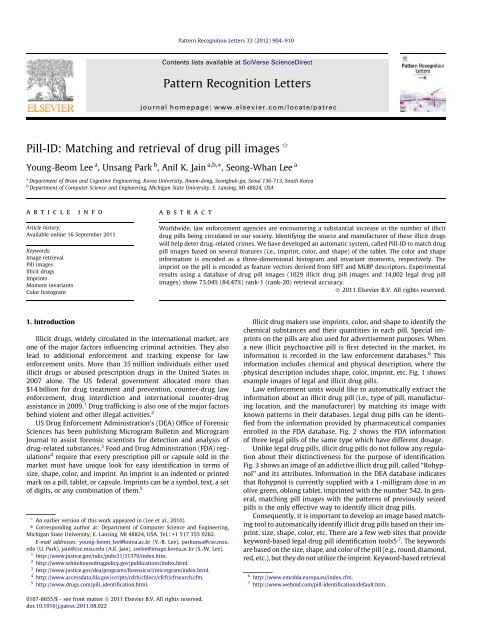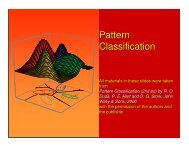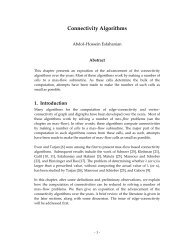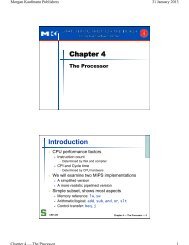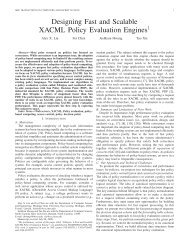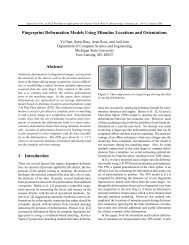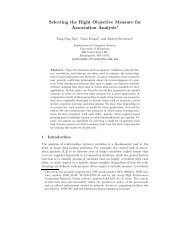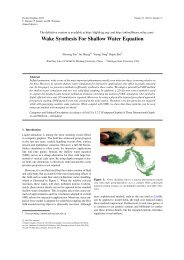Pill-ID: Matching and retrieval of drug pill images - Department of ...
Pill-ID: Matching and retrieval of drug pill images - Department of ...
Pill-ID: Matching and retrieval of drug pill images - Department of ...
- No tags were found...
Create successful ePaper yourself
Turn your PDF publications into a flip-book with our unique Google optimized e-Paper software.
Pattern Recognition Letters 33 (2012) 904–910Contents lists available at SciVerse ScienceDirectPattern Recognition Lettersjournal homepage: www.elsevier.com/locate/patrec<strong>Pill</strong>-<strong>ID</strong>: <strong>Matching</strong> <strong>and</strong> <strong>retrieval</strong> <strong>of</strong> <strong>drug</strong> <strong>pill</strong> <strong>images</strong> qYoung-Beom Lee a , Unsang Park b , Anil K. Jain a,b,⇑ , Seong-Whan Lee aa <strong>Department</strong> <strong>of</strong> Brain <strong>and</strong> Cognitive Engineering, Korea University, Anam-dong, Seongbuk-gu, Seoul 136-713, South Koreab <strong>Department</strong> <strong>of</strong> Computer Science <strong>and</strong> Engineering, Michigan State University, E. Lansing, MI 48824, USAarticleinfoabstractArticle history:Available online 16 September 2011Keywords:Image <strong>retrieval</strong><strong>Pill</strong> <strong>images</strong>Illicit <strong>drug</strong>sImprintsMoment invariantsColor histogramWorldwide, law enforcement agencies are encountering a substantial increase in the number <strong>of</strong> illicit<strong>drug</strong> <strong>pill</strong>s being circulated in our society. Identifying the source <strong>and</strong> manufacturer <strong>of</strong> these illicit <strong>drug</strong>swill help deter <strong>drug</strong>-related crimes. We have developed an automatic system, called <strong>Pill</strong>-<strong>ID</strong> to match <strong>drug</strong><strong>pill</strong> <strong>images</strong> based on several features (i.e., imprint, color, <strong>and</strong> shape) <strong>of</strong> the tablet. The color <strong>and</strong> shapeinformation is encoded as a three-dimensional histogram <strong>and</strong> invariant moments, respectively. Theimprint on the <strong>pill</strong> is encoded as feature vectors derived from SIFT <strong>and</strong> MLBP descriptors. Experimentalresults using a database <strong>of</strong> <strong>drug</strong> <strong>pill</strong> <strong>images</strong> (1029 illicit <strong>drug</strong> <strong>pill</strong> <strong>images</strong> <strong>and</strong> 14,002 legal <strong>drug</strong> <strong>pill</strong><strong>images</strong>) show 73.04% (84.47%) rank-1 (rank-20) <strong>retrieval</strong> accuracy.Ó 2011 Elsevier B.V. All rights reserved.1. IntroductionIllicit <strong>drug</strong>s, widely circulated in the international market, areone <strong>of</strong> the major factors influencing criminal activities. They alsolead to additional enforcement <strong>and</strong> tracking expense for lawenforcement units. More than 35 million individuals either usedillicit <strong>drug</strong>s or abused prescription <strong>drug</strong>s in the United States in2007 alone. The US federal government allocated more than$14 billion for <strong>drug</strong> treatment <strong>and</strong> prevention, counter-<strong>drug</strong> lawenforcement, <strong>drug</strong> interdiction <strong>and</strong> international counter-<strong>drug</strong>assistance in 2009. 1 Drug trafficking is also one <strong>of</strong> the major factorsbehind violent <strong>and</strong> other illegal activities. 2US Drug Enforcement Administration’s (DEA) Office <strong>of</strong> ForensicSciences has been publishing Microgram Bulletin <strong>and</strong> MicrogramJournal to assist forensic scientists for detection <strong>and</strong> analysis <strong>of</strong><strong>drug</strong>-related substances. 3 Food <strong>and</strong> Drug Administration (FDA) regulations4 require that every prescription <strong>pill</strong> or capsule sold in themarket must have unique look for easy identification in terms <strong>of</strong>size, shape, color, <strong>and</strong> imprint. An imprint is an indented or printedmark on a <strong>pill</strong>, tablet, or capsule. Imprints can be a symbol, text, a set<strong>of</strong> digits, or any combination <strong>of</strong> them. 5q An earlier version <strong>of</strong> this work appeared in (Lee et al., 2010).⇑ Corresponding author at: <strong>Department</strong> <strong>of</strong> Computer Science <strong>and</strong> Engineering,Michigan State University, E. Lansing, MI 48824, USA. Tel.: +1 517 355 9282.E-mail addresses: young-beom_lee@korea.ac.kr (Y.-B. Lee), parkunsa@cse.msu.edu (U. Park), jain@cse.msu.edu (A.K. Jain), swlee@image.korea.ac.kr (S.-W. Lee).1 http://www.justice.gov/ndic/pubs31/31379/index.htm.2 http://www.whitehouse<strong>drug</strong>policy.gov/publications/index.html.3 http://www.justice.gov/dea/programs/forensicsci/microgram/index.html.4 http://www.accessdata.fda.gov/scripts/cdrh/cfdocs/cfcfr/cfrsearch.cfm.5 http://www.<strong>drug</strong>s.com/<strong>pill</strong>_identification.html.Illicit <strong>drug</strong> makers use imprints, color, <strong>and</strong> shape to identify thechemical substances <strong>and</strong> their quantities in each <strong>pill</strong>. Special imprintson the <strong>pill</strong>s are also used for advertisement purposes. Whena new illicit psychoactive <strong>pill</strong> is first detected in the market, itsinformation is recorded in the law enforcement databases. 6 Thisinformation includes chemical <strong>and</strong> physical description, where thephysical description includes shape, color, imprint, etc. Fig. 1 showsexample <strong>images</strong> <strong>of</strong> legal <strong>and</strong> illicit <strong>drug</strong> <strong>pill</strong>s.Law enforcement units would like to automatically extract theinformation about an illicit <strong>drug</strong> <strong>pill</strong> (i.e., type <strong>of</strong> <strong>pill</strong>, manufacturinglocation, <strong>and</strong> the manufacturer) by matching its image withknown patterns in their databases. Legal <strong>drug</strong> <strong>pill</strong>s can be identifiedfrom the information provided by pharmaceutical companiesenrolled in the FDA database. Fig. 2 shows the FDA information<strong>of</strong> three legal <strong>pill</strong>s <strong>of</strong> the same type which have different dosage.Unlike legal <strong>drug</strong> <strong>pill</strong>s, illicit <strong>drug</strong> <strong>pill</strong>s do not follow any regulationabout their distinctiveness for the purpose <strong>of</strong> identification.Fig. 3 shows an image <strong>of</strong> an addictive illicit <strong>drug</strong> <strong>pill</strong>, called ‘‘Rohypnol’’<strong>and</strong> its attributes. Information in the DEA database indicatesthat Rohypnol is currently supplied with a 1-milligram dose in anolive green, oblong tablet, imprinted with the number 542. In general,matching <strong>pill</strong> <strong>images</strong> with the patterns <strong>of</strong> previously seized<strong>pill</strong>s is the only effective way to identify illicit <strong>drug</strong> <strong>pill</strong>s.Consequently, it is important to develop an image based matchingtool to automatically identify illicit <strong>drug</strong> <strong>pill</strong>s based on their imprint,size, shape, color, etc. There are a few web sites that providekeyword-based legal <strong>drug</strong> <strong>pill</strong> identification tools5 ,7 . The keywordsare based on the size, shape, <strong>and</strong> color <strong>of</strong> the <strong>pill</strong> (e.g., round, diamond,red, etc.), but they do not utilize the imprint. Keyword-based <strong>retrieval</strong>6 http://www.emcdda.europa.eu/index.cfm.7 http://www.webmd.com/<strong>pill</strong>-identification/default.htm.0167-8655/$ - see front matter Ó 2011 Elsevier B.V. All rights reserved.doi:10.1016/j.patrec.2011.08.022
906 Y.-B. Lee et al. / Pattern Recognition Letters 33 (2012) 904–910Fig. 4. Schematic <strong>of</strong> the <strong>Pill</strong>-<strong>ID</strong> system.magnitude <strong>images</strong>. The gradient magnitude image has smaller intra-classvariations compared to color or gray scale <strong>images</strong>. The featureextraction methods (i.e., SIFT <strong>and</strong> MLBP) also provide bettermatching accuracy when they were applied to the gradient magnitude<strong>images</strong> compared to gray scale <strong>images</strong>.3.2. Imprint descriptor construction3.2.1. SIFT descriptorScale Invariant Feature Transform (SIFT) (Lowe, 2004) is one <strong>of</strong>the most popular local representation schemes used for object recognition<strong>and</strong> CBIR. Computation <strong>of</strong> SIFT features consists <strong>of</strong> twoFig. 5. Color, gray scale, <strong>and</strong> gradient magnitude <strong>images</strong>. (a) Input color image, (b)gray scale image, <strong>and</strong> (c) gradient magnitude image.stages: (i) keypoint extraction, <strong>and</strong> (ii) descriptor calculation in alocal neighborhood at each keypoint. In our application, for computationalefficiency, we place a regular grid <strong>of</strong> l<strong>and</strong>marks within apreset radius on the <strong>pill</strong> image instead <strong>of</strong> extracting keypoints. Aset <strong>of</strong> keypoints (=29) are selected within a circle with radius <strong>of</strong>60 pixels with 20 pixels spacing. SIFT descriptors are constructedin 64 64 windows placed at each l<strong>and</strong>mark. Gradient magnitudeat each pixel is accumulated in accordance with its orientationwhich is summarized into an 8-bin orientation histogram. The gradientmagnitude <strong>and</strong> orientation are calculated using M(x,y) assffiffiffiffiffiffiffiffiffiffiffiffiffiffiffiffiffiffiffiffiffiffiffiffiffiffiffiffiffiffiffiffiffiffiffiffiffiffiffiffiffiffiffiffiffiffiffiffiffiffiffiffiffiffiffiffiffiffiffiffi @Mðx; yÞ 2 2M m ðx; yÞ ¼@xþ @Mðx; yÞ@y @Mðx; yÞ @Mðx; yÞO m ðx; yÞ ¼arctan@y @xThe features obtained from all the sub-windows are concatenatedfrom left to right <strong>and</strong> top to bottom to construct the final featurevector with a dimensionality <strong>of</strong> 3712 (29 128).The original SIFT descriptor (Lowe, 2004) construction consisted<strong>of</strong> five steps: (i) smoothing, (ii) gradient orientation <strong>and</strong> magnitudecalculation, (iii) Gaussian weighting, (iv) tri-linear interpolation,<strong>and</strong> (v) truncation. We have empirically determined that steps (i)<strong>and</strong> (iii) are redundant in generating robust feature vectors forour application. The smoothing operation is already applied in generatingthe gradient magnitude image, so step (i) leads to oversmoothing,resulting in a loss <strong>of</strong> matching accuracy. We have alsoobserved a drop in the matching accuracy after applying the Gaussianweighting, which indicates that the information contained ineach sub-window is equally important. This is also partly due tothe fact that, in our application, the keypoints are preset on a grid.Fig. 6 shows the schematics <strong>of</strong> tri-linear interpolation <strong>and</strong> truncationsteps in the SIFT descriptor construction.ð2Þð3Þ
Y.-B. Lee et al. / Pattern Recognition Letters 33 (2012) 904–910 9073.2.2. MLBP descriptorMulti-scale Local Binary Pattern (MLBP) (Ojala et al., 2002)descriptor is another well known method to construct a featuredescriptor. MLBP descriptor is the extended variation <strong>of</strong> the LBPdescriptor by considering multiple radii <strong>and</strong> neighboring pixel sets.There is a trade-<strong>of</strong>f between the matching accuracy <strong>and</strong> computationalrequirement in constructing the MLBP descriptor. Small values<strong>of</strong> radii <strong>and</strong> number <strong>of</strong> neighboring pixels leads to lowmatching accuracy, whereas large values <strong>of</strong> radii <strong>and</strong> neighboringpixels leads to high computational cost.We used two different radii, R = {1,2} <strong>and</strong> three different numbers<strong>of</strong> neighboring pixels, P = {8,4,12} for effective feature vectorconstruction. This results in six different parameter sets. MLBP histogramsassociated with each parameter set are constructed withineach sub-window analogous to the SIFT descriptor. Histogramsfrom different parameter sets are concatenated to form the finalfeature vector. Even though we only selected two different values<strong>of</strong> R <strong>and</strong> three different values <strong>of</strong> P, this still results in a large featurevector with a dimensionality <strong>of</strong> 3344 for each sub-window. Toavoid the curse <strong>of</strong> dimensionality, we down sample the feature vectorsby grouping every 16 consecutive feature values <strong>and</strong> taking thesummation (reduction factor <strong>of</strong> 1/16). The final lengths <strong>of</strong> SIFT <strong>and</strong>MLBP descriptors are 3712 <strong>and</strong> 6061, respectively. Fig. 7 shows theparameter sets that we used for constructing the MLBP descriptors.3.3. ColorThe color feature vector is represented as a histogram. In general,the color histogram provides useful clues for the subsequentexpression <strong>of</strong> similarity between <strong>images</strong>, due to its robustness tobackground complexity <strong>and</strong> object distortion (Wang et al., 2010).A three-dimensional histogram is obtained by equally dividingeach <strong>of</strong> the red, green, <strong>and</strong> blue color channels (0–255) into fourbins (4 4 4 = 64 bin histogram). The color histogram is definedash½C R ; C G ; C B Š¼N p Probfr 2 C R ; g 2 C G ; b 2 C B gwhere C R , C G , <strong>and</strong> C B denote bins <strong>of</strong> each color channel, r, g, <strong>and</strong> b arethe RGB color value <strong>of</strong> a pixel, respectively <strong>and</strong> N p is the total number<strong>of</strong> pixels in the image (Smith <strong>and</strong> Chang, 1996). To calculate thesimilarity between two color histograms, we compute their correlationusing the Bhattacharyya coefficient (Bhattacharyya, 1943),defined asBCðp; qÞ ¼ X xpffiffiffiffiffiffiffiffiffiffiffiffiffiffiffiffiffipðxÞqðxÞwhere p(x) <strong>and</strong> q(x) are the discrete color histograms.ð4Þð5Þ3.4. ShapeWe extract the invariant moments only from the <strong>pill</strong> boundaryshape because the shape <strong>of</strong> imprints are encoded in the SIFT <strong>and</strong>MLBP based descriptors. From the gradient magnitude image, weextract the most significant outer boundary <strong>of</strong> the <strong>pill</strong> <strong>and</strong> use aset <strong>of</strong> moment invariants introduced by Hu (1962) to constructthe shape feature vector.Given the gradient magnitude image M(x,y), the centralmoment <strong>of</strong> order (a + b) is defined asl a;b¼ X ðx;yÞðx xÞ a ðy yÞ b Mðx; yÞ ð6Þwhere ðx; yÞ is the center <strong>of</strong> the image. Scale invariant moments g i,j ,where (i + j) P 2 can be constructed by using the following formula.g i;j¼ðl i;jÞl 1þiþj 20;0Fig. 7. Schematic <strong>of</strong> the MLBP descriptor construction.Based on the 2nd <strong>and</strong> 3rd order moments ((i + j) = 2,3), a set <strong>of</strong>seven features are obtained (Hu, 1962). The features are derivedfrom algebraic invariants applied to the moment generating functionunder a rotation transformation. The result is a set <strong>of</strong> sevenmoment invariants, which can be used for scale, position, <strong>and</strong> rotationinvariant pattern identification.3.5. Rotation normalizationGiven a gradient magnitude image, M(x,y), we calculate the gradientorientation at each pixel (Eq. (3)) <strong>and</strong> construct a 36-bin orientationhistogram. Similar to the major orientation decisionscheme for each keypoint in SIFT, we first select the most dominantorientation. Then, all other orientations within 80% <strong>of</strong> the mostdominant orientation value are also selected as major orientations.For each major orientation, the gradient magnitude image isrotated, so that each major orientation aligns with the leftmostside <strong>of</strong> each <strong>pill</strong> image. This results in enrolling multiple templatesfor a <strong>pill</strong>, one corresponding to each major orientation. All thesetemplates are stored in the database <strong>and</strong> used during the matchingstage. Number <strong>of</strong> major orientations obtained for <strong>pill</strong> <strong>images</strong> in ourdatabase varies from 1 to 17. Since the invariant moments <strong>and</strong> colorvalues are rotation invariant, we apply this rotation normalizationprocess only to the imprint descriptor construction.ð7Þ3.6. <strong>Matching</strong>Fig. 6. Schematic <strong>of</strong> the SIFT descriptor construction.Since we generate multiple templates from each image to h<strong>and</strong>lerotation variations, we need to evaluate a large number <strong>of</strong> matchings.Suppose K m is the number <strong>of</strong> templates <strong>of</strong> the mth query image<strong>and</strong> L n is the number <strong>of</strong> templates <strong>of</strong> the nth gallery image. The closestmatch <strong>of</strong> the mth query in the gallery is selected as<strong>ID</strong> m ¼ arg min dq inm ; gj nwhere n =1,...,N, i =1,...,K m , j =1,...,L n <strong>and</strong> d(,) is the distancemetric based on the L 2 -norm. The <strong>ID</strong>(=n) <strong>of</strong> the closest gallery imageis assigned as the <strong>ID</strong> <strong>of</strong> the query (see Fig. 8). We calculate theð8Þ
908 Y.-B. Lee et al. / Pattern Recognition Letters 33 (2012) 904–910Fig. 8. A schematic <strong>of</strong> the proposed matching scheme using multiple templates.Fig. 9. Duplicate <strong>images</strong> in our database <strong>and</strong> their feature properties. ‘‘Coca-Cola’’ isthe imprint name <strong>and</strong> Gray-03 represents the third category among the sevendifferent classes <strong>of</strong> gray color. All properties are assigned passively <strong>and</strong> used in thematching stage.matching accuracy using individual feature descriptors as well astheir combinations. Min–max normalization <strong>and</strong> weighted summethod are used for the fusion (Jain et al., 2005). The final matchingaccuracy is evaluated using three different strategies: (i) using <strong>pill</strong>imprint only, (ii) using <strong>pill</strong> imprint <strong>and</strong> color, <strong>and</strong> (iii) using <strong>pill</strong> imprint,color, <strong>and</strong> shape.4. Experimental results4.1. DatabaseWe received 891 illicit <strong>drug</strong> <strong>pill</strong> <strong>images</strong> from the Australian FederalPolice. We also downloaded 138 illicit <strong>drug</strong> <strong>pill</strong> <strong>images</strong> <strong>and</strong>14,002 legal <strong>pill</strong> <strong>images</strong> from the following web sites: US DrugEnforcement Administration’s Office <strong>of</strong> Forensic Sciences (DEA),Drug information online, 5 <strong>and</strong> pharmer.org. 8 Thus, we have a total<strong>of</strong> 15,031 <strong>pill</strong> <strong>images</strong>. The image size <strong>of</strong> the <strong>pill</strong> varies from 48 42to 2088 1550 (width height) with 96 dpi resolution.To evaluate the <strong>Pill</strong>-<strong>ID</strong> system, we first identified duplicate<strong>images</strong> in our database. Duplicate <strong>images</strong> in the database implythat the same type <strong>of</strong> <strong>pill</strong> was imaged two or more times (in thecase <strong>of</strong> illicit <strong>drug</strong>s, it means the same illicit <strong>pill</strong> was seized severaltimes <strong>and</strong> recorded in the database). To establish a ground truth forcomputing the <strong>retrieval</strong> accuracy, we assigned a unique identificationnumber to each <strong>pill</strong> image based on imprint, shape <strong>of</strong> <strong>pill</strong>boundary, <strong>and</strong> color information. <strong>Pill</strong> <strong>images</strong> that have the sameimprint, <strong>pill</strong> boundary shape, <strong>and</strong> color are assigned the same <strong>ID</strong>.We used Munsell color system (Wyszecki <strong>and</strong> Stiles, 1967) toassign color labels. The color space is divided into 10 categories(red, yellow–red, yellow, green-yellow, green, blue-green, blue,purple-blue, purple, red–purple) <strong>and</strong> into seven categories for graylevels. Wide usage <strong>of</strong> Munsell color system by American NationalSt<strong>and</strong>ard Institute (ANSI) <strong>and</strong> United States Geological Survey(USGS) shows its effectiveness.Shape is also labeled in a similar manner as color with representativeshape primitives (e.g., round, ellipse, egg, barrel, rectangle,3,4,5,6,7,8-folded, Smurf, kidney, etc.). The total number <strong>of</strong> duplicate<strong>images</strong> identified is 7637. We use 105 <strong>and</strong> 100 distinct patterns<strong>of</strong> illicit <strong>and</strong> legal <strong>pill</strong> <strong>images</strong>, respectively as query <strong>and</strong> theentire database as gallery. Therefore, the total number <strong>of</strong> query<strong>images</strong> is 805 (444 illicit <strong>and</strong> 361 legal <strong>images</strong> <strong>of</strong> 205 distinct patterns).Fig. 9 shows example duplicate <strong>images</strong> in our database. Incase the color information is irrelevant (e.g., a color image is storedas gray scale), a <strong>retrieval</strong> process using only imprint <strong>and</strong> shape canbe considered.8 http://www.pharmer.org/<strong>images</strong>.Fig. 10. CMC curves showing the <strong>retrieval</strong> performance. The rank-1 accuracyrepresents the percentage <strong>of</strong> queries whose correct mate is retrieved as the closestmatch.4.2. <strong>Matching</strong> accuracyThe performance <strong>of</strong> the <strong>Pill</strong>-<strong>ID</strong> system is evaluated using CumulativeMatch Characteristic Curve (CMC). The CMC curves are computedbased on 805 queries <strong>and</strong> 15,031 gallery <strong>images</strong>. The CMCcurves <strong>of</strong> the MLBP descriptor, SIFT descriptor <strong>and</strong> SIFT + color +shape are shown in Fig. 10. The matching scores using imprints,color, <strong>and</strong> shape are summed with empirically chosen weightsfor corresponding set <strong>of</strong> features under consideration to calculatethe CMC curves in Fig. 10.Example matching results for ten queries using imprint, color,<strong>and</strong> shape features are shown in Fig. 11(a). The first five queriesin Fig. 11(a) are correctly matched at rank-1. The last five queriesare not matched correctly at rank-1, but they were correctlymatched in the top 20 ranks. Fig. 11(b) shows failed matchingexamples in the top 20 ranks. These failures are due to the analogousimprints <strong>and</strong> colors between queries <strong>and</strong> top retrieved <strong>images</strong><strong>and</strong> wrong segmentation. Fig. 12 shows <strong>retrieval</strong> results <strong>of</strong> fourqueries that failed to match at rank-1. The first two rows failedto match using imprint only, but were successfully matched usingimprint <strong>and</strong> color. The queries in the third <strong>and</strong> fourth rows <strong>of</strong>Fig. 12 failed to match using imprint <strong>and</strong> color but succeeded usingimprint, color, <strong>and</strong> shape.We make the following observations based on these experimentalresults: (i) use <strong>of</strong> the color feature with imprint (SIFT representation)shows significant improvement compared to the use <strong>of</strong>imprint only, (ii) the Munsell color system helps to differentiateimprint patterns with different colors, <strong>and</strong> (iii) the use <strong>of</strong> <strong>pill</strong> shapemarginally improved the matching performance. In law enforcementapplications, it is customary to examine the top-20 <strong>retrieval</strong>s.
Y.-B. Lee et al. / Pattern Recognition Letters 33 (2012) 904–910 909Fig. 11. Example matching results using imprint, color, <strong>and</strong> shape features. (a) Correct <strong>retrieval</strong>s in the top-20 retrieved <strong>images</strong> <strong>and</strong> (b) failed <strong>retrieval</strong>s in the top-20 retrieved<strong>images</strong>. Correct matches are encoded with red boxes.The <strong>retrieval</strong> time per query with 15 K gallery <strong>images</strong> is 13.0 <strong>and</strong>4.0 s, respectively. The feature extraction <strong>and</strong> matching times forshape <strong>and</strong> color are negligible.5. Conclusions <strong>and</strong> future workFig. 12. Retrieval examples using different combinations <strong>of</strong> features.Keeping this in mind, our top-20 <strong>retrieval</strong> accuracy <strong>of</strong> about 84% isquite good.The proposed method is implemented in Matlab on a 2.4 GHzprocessor with 4 GB memory. The average feature extraction timebased on SIFT <strong>and</strong> MLBP descriptors are 2.3 <strong>and</strong> 0.5 s, respectively.We have developed an automatic <strong>drug</strong> <strong>pill</strong> matching <strong>and</strong> <strong>retrieval</strong>system. The system has been tested on a <strong>pill</strong> image databasecontaining a total <strong>of</strong> 15,031 <strong>images</strong>, including 1029 illicit <strong>drug</strong> <strong>pill</strong><strong>images</strong>. Rank-1 (Rank-20) identification accuracy <strong>of</strong> 73.17%(84.47%) is obtained in the matching experiments. These accuracyvalues are quite good, given the similarity in shape, color, <strong>and</strong>imprint information in many <strong>of</strong> the <strong>pill</strong>s. This system can be usedto identify illegal <strong>drug</strong> <strong>pill</strong>s to assist law enforcement units by providinginformation such as their chemical composition, manufacturer,<strong>and</strong> manufacturing location for investigative purposes. Theproposed illicit <strong>drug</strong> <strong>pill</strong> identification system can also be used toidentify legal <strong>drug</strong> <strong>pill</strong>s or tablets when the prescription informationis missing. We are improving the performance <strong>of</strong> the currentsystem by recognizing the textual information in the imprints (digitsor characters) with an Optical Character Reader (OCR). Theextended method will especially help in identifying <strong>pill</strong>s withmissing or damaged imprints.
910 Y.-B. Lee et al. / Pattern Recognition Letters 33 (2012) 904–910AcknowledgmentsThe authors thank Dr. Mark Tahtouh <strong>of</strong> the Australian FederalPolice for providing <strong>drug</strong> <strong>pill</strong> <strong>images</strong>. Anil K. Jain’s research waspartially supported by WCU (World Class University) programthrough the National Research Foundation <strong>of</strong> Korea funded bythe Ministry <strong>of</strong> Education, Science <strong>and</strong> Technology (R31-10008)to Korea university.ReferencesBhattacharyya, A., 1943. On a measure <strong>of</strong> divergence between two statisticalpopulations defined by probability distributions. Bull. Calcutta Math. Soc. 35,99–109.Chang, S.-K., Liu, S.-H., 1984. Picture indexing <strong>and</strong> abstraction techniques forpictorial databases. IEEE Trans. Pattern Anal Machine Intell. 6 (4), 475–484.Flickner, M., Sawhney, H., Niblack, W., Ashley, J., Huang, Q., Dom, B., Gorkani, M.,Hafner, J., Lee, D., Petkovic, D., Steele, D., Yanker, P., 1995. Query by image <strong>and</strong>video content: The QBIC system. Computer 28 (9), 23–32.Geradts, Z., Bijhold, J., 2002. Content based information <strong>retrieval</strong> in forensic imagedatabases. J. Forensic Sci. 47 (2), 285–292.Gonzalez, R., Woods, R., 1992. Digital Image Processing, 2nd ed. Addison-WesleyLongman Publishing Co., Inc, Boston, MA.Hu, M.-K., 1962. Visual pattern recognition by moment invariants. IEEE Trans.Inform. Theor. 8 (2), 179–187.Jain, A., N<strong>and</strong>akumar, K., Ross, A., 2005. Score normalization in multimodalbiometric systems. Pattern Recognit. 38 (12), 2270–2285.Jain, A., Lee, J., Jin, R., Gregg, N., 2009. Content-based image <strong>retrieval</strong>: An applicationto tattoo <strong>images</strong>. In: 16th IEEE International Conference on Image Processing,pp. 2745–2748.Kato, T., 1992. Database architecture for content-based image <strong>retrieval</strong>. In:Proceedings <strong>of</strong> SPIE, vol. 1662. p. 112.Lee, Y.-B., Park, U., Jain, A.K., 2010. <strong>Pill</strong>-<strong>ID</strong>: <strong>Matching</strong> <strong>and</strong> <strong>retrieval</strong> <strong>of</strong> <strong>drug</strong> <strong>pill</strong>imprint <strong>images</strong>. In: Proceedings <strong>of</strong> the 20th International Conference on PatternRecognition, pp. 2632–2635.Lowe, D., 2004. Distinctive image features from scale-invariant keypoints. Internat.J. Comput. Vision 60 (2), 91–110.Ojala, T., Pietikainen, M., Maenpaa, T., 2002. Multiresolution gray-scale <strong>and</strong> rotationinvariant texture classification with local binary patterns. IEEE Trans. PatternAnal. Machine Intell. 24 (7), 971–987.Riesenhuber, M., Poggio, T., 2000. Models <strong>of</strong> object recognition. Nat. Neurosci.Supplement 3, 1199–1204.Smith, J., Chang, S., 1996. Tools <strong>and</strong> techniques for color image <strong>retrieval</strong>. Proc. SPIEStorage Retrieval Image Video Databases IV 2670, 426–437.Wang, X., Wu, J., Yang, H., 2010. Robust image <strong>retrieval</strong> based on color histogram <strong>of</strong>local feature regions. Multimedia Tools Appl. 49 (2), 323–345.Wyszecki, G., Stiles, W., 1967. Color Science. Wiley, New York.


